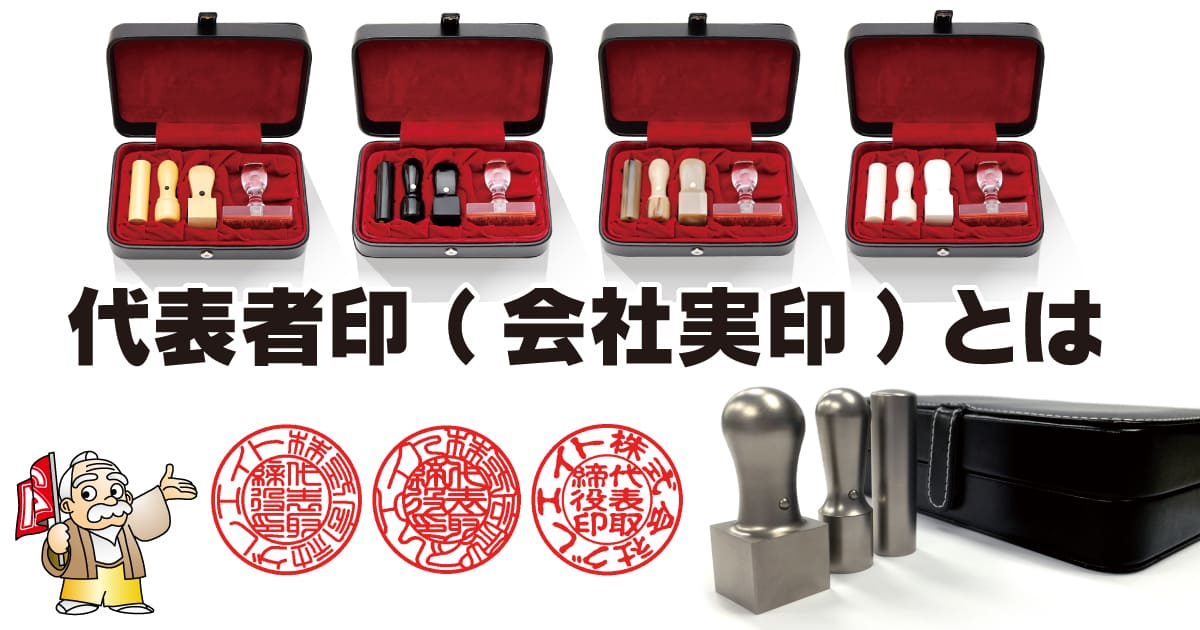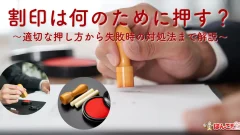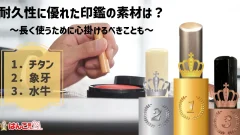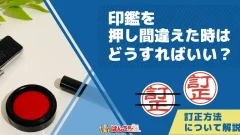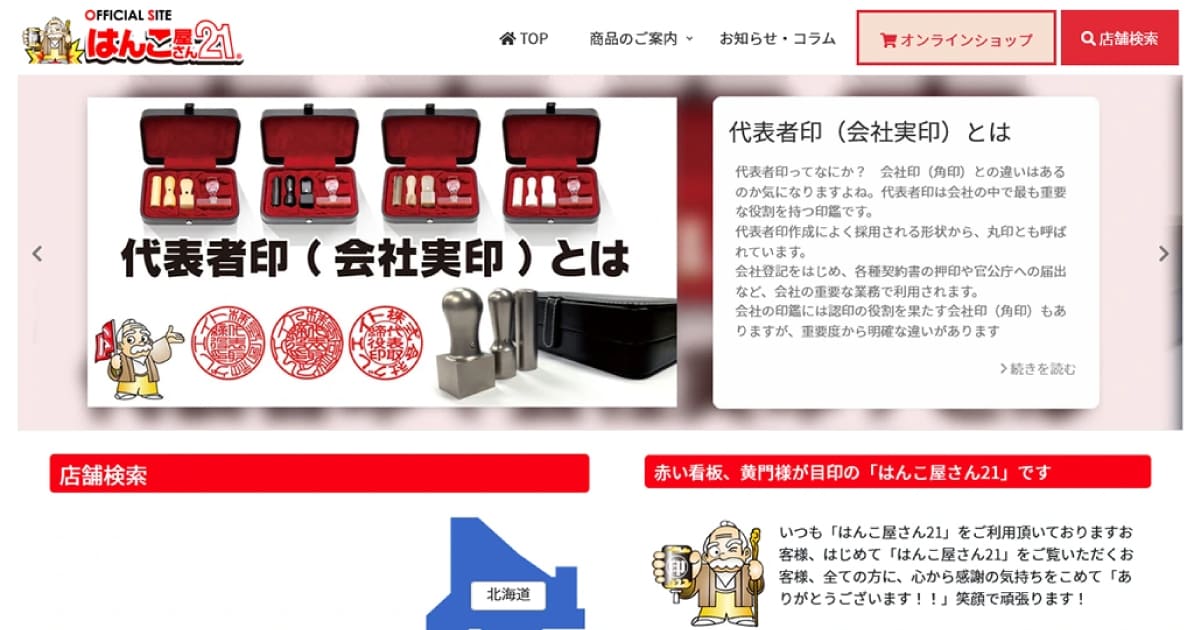In this article, we will explain the outline of the representative seal and how to create it. Currently, HANKO such as electronic HANKO are being digitized and converted into data, but legally a digitalized representative seal cannot fulfill its original role as a representative seal. Even today, the representative seal is the only HANKO within a company that cannot be duplicated. The article also introduces how to manage your representative seal and what to do if you lose it, so please refer to it.
What is the representative seal?
A representative seal is a HANKO used to publicly indicate the decision of a company's representative. It is created when a company is established and is also the HANKO that is registered when registering at the Legal Affairs Bureau, so all companies own it. It can be said to be the most authoritative HANKO within a company, as it is used in important aspects of company management, such as when establishing a company, concluding a contract, and filing notifications with government offices.


Scenes in which the representative seal is used
We will introduce the scenes in which the representative seal is used.
- Stamping when establishing or changing internal regulations, such as when establishing a company, changing officers, or applying for a change in registration.
- Stamping when applying for and renewing permits to government offices
- Seal on the contract concluded by the company
- Seal stamp when delegating work to an expert, etc.
- Stamping when issuing stocks and buying and selling real estate
As a side note, although it is called a representative seal, there is no need to change the HANKO even if the company's representative changes. This is because the name of the representative is not engraved on the representative seal. It is simply a way to show the decision-making of the "representative of the company" to the outside world. Also, just because it is a company HANKO, there is no need to affix the representative's seal to unimportant company documents. When issuing invoices or receipts, a company seal (square seal) is often used as it serves as a seal.
Difference from company seal (square seal)
As mentioned above, company seals (square seals) are used for stamping in daily work. Its role is similar to that of a personal seal, and is used to issue invoices, receipts, estimates, etc. Some companies create multiple company seals (square seals) and allow employees, especially those in the accounting department, to use them.
- Representative seal: serves as a registered seal and must be registered with the Legal Affairs Bureau. The HANKO is engraved with the company name and position, and is used for stamping contracts and documents submitted to government offices.
- Company seal: serves as a seal and does not need to be registered with the Legal Affairs Bureau. The HANKO has only the company name engraved on it and is used to stamp invoices and receipts.
Use with company seal
A company seal (square seal) serves as a seal, but if a contract does not require a HANKO certificate, a company seal can also be affixed and is legally valid. In addition, it is of course possible to use the representative seal (circle seal), which is the company's registered seal, to stamp receipts and other documents issued in daily operations. However, it is better to clearly separate the usage of the representative seal and the company seal. This is because in an environment where employees can freely use the representative seal like a registered seal, there is a risk of it being forged or taken out. If the estimate is stamped with a real seal or the HANKO on the contract is a certified seal, the other party may have doubts and may lose confidence in the company. Please use it properly with the company seal.
Use with bank stamp
There is one more HANKO that should be used properly. It's a bank seal. A bank seal is used when registering with a financial institution or making a withdrawal at a bank. When creating a set of HANKO when establishing a company, there are many cases where the set includes one square stamp and two round stamps. One of the two round seals is a representative seal, while the other, a smaller personal HANKO, is often used as a bank seal, and the importance of the three HANKO is as follows: representative seal>bank seal>company seal (square seal), so make sure to use bank seals as well as company seals.
How to stamp the representative seal
The representative seal is generally affixed at the end of the document, on the right side of the document where the company name, title, and name are written. Some people affix their seal so that it overlaps with their company name or name, but depending on the contract, it may be necessary to check it against a HANKO certificate. It is a good idea to stamp your seal so that the letters do not overlap so that you can compare the certificate and your seal impression. Also, if the word "Seal" is written on the right side of the company name, title, or name, place the seal so that the "Seal" is in the center.
Standards for representative seals
When creating a representative seal, it is necessary to comply with two regulations stipulated by the Legal Affairs Bureau.
Size regulations
The first regulation is size. According to Article 9, Paragraph 3 of the Commercial Registration Regulations, ``The size of a HANKO must not fit within a square with sides of 1 cm or larger than a square with sides of 3 cm. .” In other words, the representative seal must be created so that it fits within a square of 10 mm or more and 30 mm or less. 18.0mm is common for a company's registered seal, and 21.0mm may be selected if the company name has a large number of characters.
Verification provisions
The second stipulation is that it can be verified. According to Article 9, Paragraph 4 of the Commercial Registration Regulations, "HANKO must be suitable for verification." Although it is an abstract expression, the general interpretation is that it is a HANKO that can be reliably verified even if the amount of pressure applied changes or even after years pass. Therefore, stamps made of easily deformable materials such as killer whale stamps and rubber stamps, which can be easily made, cannot be registered as representative stamps. This is because there is a high possibility that it will become distorted due to the amount of force applied to it, or that it will chip or deteriorate due to long-term use. Materials with high hardness such as ivory, buffalo, titanium, and wood are suitable materials for HANKO. However, there are no strict regulations regarding the shape of the seal or the contents of the HANKO. It is possible to engrave an abbreviation, etc., but be sure to write something that identifies the company or representative.
Points to note when creating a representative seal
We will explain each point when creating a representative seal.
Shape of HANKO
The first one is about the shape of the HANKO. The shape refers to the shape of the handle of the HANKO. There are two types of HANKO, the round type and the round bar type. The Tenmaru type has a shape that constricts toward the center, making it easy to hold and giving it a solid feel, and is the shape chosen by many representative seals. On the other hand, the round bar type has the same simple shape as personal registered seals and bank seals, and if the representative seal is a ten circle, many companies choose to use the round bar type for bank seals as a distinction.
HANKO material
The second thing is about the material of the HANKO. As stipulated by the Legal Affairs Bureau, it is necessary to use materials that are highly durable and do not deform due to the amount of force applied. The main types of materials include ivory, buffalo, titanium, and wood. Ivory has long been a popular stamp material due to its durability and ease of stamping. Black buffalo and Dutch buffalo are made from the core of buffalo horn, and are highly durable and have a unique texture. Titanium is a metal that is strong and lightweight. Wood has dense fibers and is hard and sticky, making it both easy to stamp and durable.
HANKO size
The third thing is about the size of the HANKO. According to the regulations of the Legal Affairs Bureau, it must fit within a square of 10 mm or more and 30 mm or less, but there are two standard sizes. It is 18mm or 21mm. There is no one that is more popular than the other, but 21mm is a larger size, so it is recommended for companies with long company names.
Contents of the seal
The fourth issue is about the character content of the seal impression of the representative seal. The representative seal is divided into two parts: an outer frame (palindrome) and an inner frame (medium letters), and it is common for the palindrome to contain the company name and the medium letter to indicate the title.
Representative seal font
The fifth point is about the font of the representative seal. There are no special regulations regarding the font, so you are free to choose as you like. However, there are three typefaces that are commonly used: ``Tensho'', ``Inso'', and ``Koin''. Inso fonts are the most difficult to read, seal fonts are intermediate, and koin fonts are the easiest to read. The recommended typeface is the seal typeface. This is because the disadvantages of other people, such as kointai being easy to read and being counterfeited, and insotai being difficult to read and difficult to use without knowing the top and bottom, can be suppressed with just the right amount of seasoning. I feel like it would be a good idea to use a typeface that is hard to read but still understandable.
Manage representative seals
Regarding how to manage representative seals, the trick to managing them effectively is to ``reduce the use of representative seals as much as possible.'' If you create a bank seal separately and include the company seal (square seal), you can reduce the frequency of use of the representative seal and reduce the chances of it being seen by others. Also, the important thing that comes with the representative seal is the HANKO card. The HANKO card is a card used to issue a HANKO certificate, so it should be managed separately from the representative seal.
What to do in case of loss
We will introduce what to do if you lose your representative seal or HANKO card.
- Lost the representative seal...The Legal Affairs Bureau will process the seal change. First, the representative seal will be abolished, and then a new HANKO will be registered as the representative seal.
- Lost your HANKO card...The Legal Affairs Bureau will abolish HANKO HANKO card and apply for a new one.
- Lost both...The Legal Affairs Bureau will abolish the HANKO and HANKO card, create a new HANKO, and then register the HANKO and apply for the issuance of the HANKO card again.
There's nothing wrong with not losing it, but it's important to be aware of it so that you can respond calmly in the unlikely event of an emergency.
summary
I will summarize the representative seal.
- A representative seal is something that certifies decision-making as a company representative.
- As a management method, store the representative seal, bank seal, company seal (square seal), and HANKO card separately, and reduce the frequency of use of the representative seal.
- In the event of loss, promptly notify the Legal Affairs Bureau and take appropriate action.
The representative seal is the most important HANKO in a company. While keeping strict management in mind, be sure to respond without panic when a problem occurs. We hope that this article will be helpful in creating and managing representative seals.
Related article
 日本語
日本語 English
English 简体中文
简体中文 繁體中文
繁體中文 한국어
한국어 ไทย
ไทย Tiếng Việt
Tiếng Việt Indonesia
Indonesia Français
Français Español
Español Português
Português
